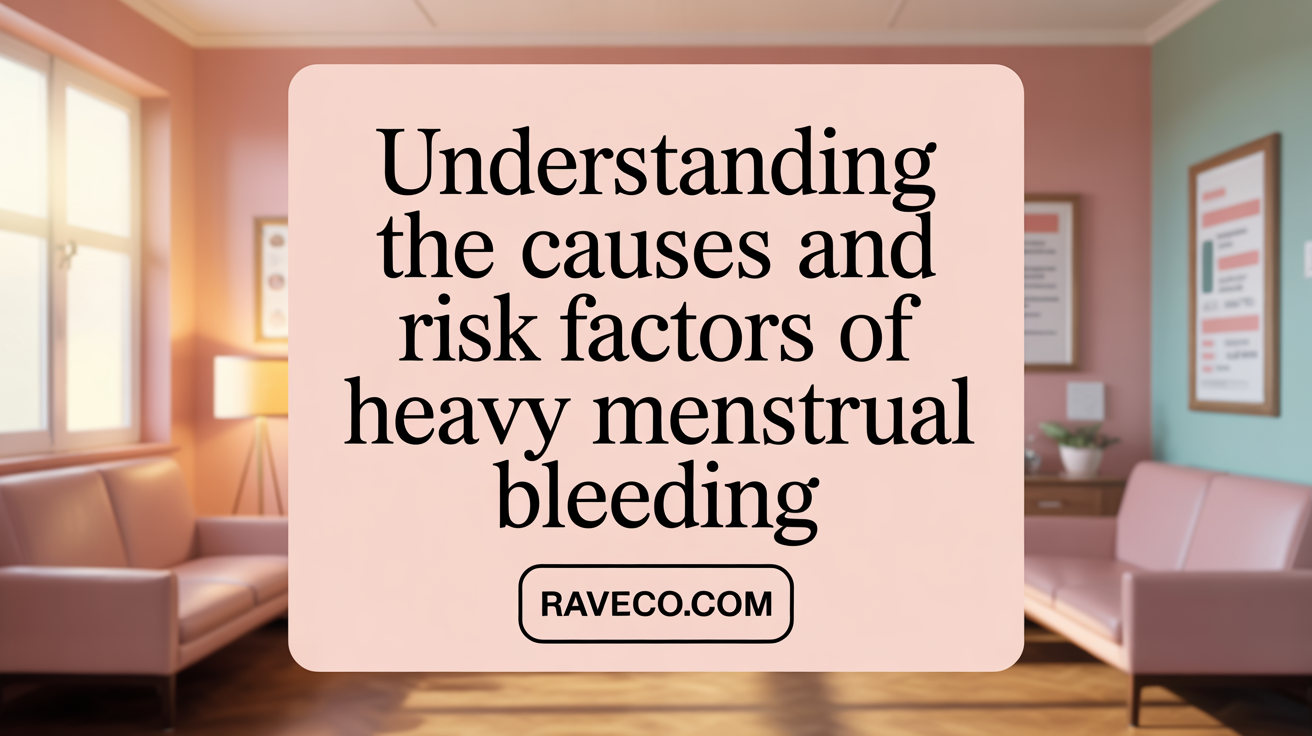Recognizing the Right Time to Address Female Infertility: Key Indicators and Expert Care in Queens

Understanding Heavy Menstrual Bleeding: The Impact and Importance of Modern Management
Heavy menstrual bleeding (HMB) is a prevalent yet often under-discussed condition that significantly affects women's health and quality of life during their reproductive years. Characterized by excessive or prolonged menstrual bleeding, it can lead to anemia, disrupt daily activities, and cause emotional distress. Modern obstetrics and gynecology offer a spectrum of diagnostic tools and management strategies tailored to address the diverse causes and severity of HMB, emphasizing individualized care and improved outcomes. This article delves into the causes, symptoms, diagnostic processes, treatment options, emergency interventions, surgical alternatives, and emerging advances in managing heavy bleeding effectively.
Causes and Risk Factors of Heavy Menstrual Bleeding

What are the primary causes and risk factors of heavy menstrual bleeding?
Heavy menstrual bleeding, or menorrhagia, often results from a range of hormonal, structural, and medical factors. The most common hormonal cause involves imbalances such as excess estrogen or inadequate progesterone production. These hormonal disruptions can lead to an overgrowth of the uterine lining (endometrium), which results in excessive bleeding during periods.
Structural issues within the uterus are significant contributors too. Uterine fibroids (leiomyomas), polyps, and adenomyosis are common conditions that increase the volume and duration of menstrual bleeding. These abnormalities can be detected with ultrasound or hysteroscopy during diagnosis.
Medical conditions play a critical role in the etiology of menorrhagia. Bleeding disorders, such as von Willebrand disease and other coagulation factor deficiencies, are identified in many women with severe bleeding. Thyroid dysfunction and liver or kidney diseases can also influence bleeding patterns by affecting hormonal balance or blood clotting mechanisms.
Medications impacting blood clotting and hormone levels, including blood thinners and hormonal contraceptives, are known to cause or exacerbate heavy menstrual flow. Furthermore, age-related factors are important, especially women approaching menopause (perimenopause), as hormonal fluctuations become more frequent. Obesity increases estrogen levels stored in fat tissue, which can further stimulate uterine lining growth and lead to heavier periods.
In addition, many women experience heavy bleeding without an identifiable cause after thorough evaluation. This condition was historically termed dysfunctional uterine bleeding but is now classified under the broader category of abnormal uterine bleeding (AUB).
The PALM-COEIN system helps categorize the causes into structural (Polyp, Adenomyosis, Leiomyoma, Malignancy) and non-structural (Coagulopathy, Ovulatory dysfunction, Endometrial, Iatrogenic, Not classified). Understanding these factors is crucial for accurate diagnosis and targeted treatment.
Recognizing Symptoms and Clinical Presentation of Abnormal Uterine Bleeding

What are the common symptoms and clinical presentations of abnormal uterine bleeding?
Abnormal uterine bleeding (AUB) often manifests through a variety of symptoms that can significantly affect a woman's daily life. The most typical signs include heavy menstrual bleeding, which involves soaking through pads or tampons every hour for several hours, passing large blood clots larger than a quarter, and bleeding that lasts longer than seven days. Women may also experience irregular or unpredictable period timing and duration, with some encountering spotting or bleeding between periods. Postmenopausal bleeding is also a notable concern, indicating possible underlying issues requiring urgent medical evaluation.
Clinical presentations can vary based on the exact cause, but generally involve deviations from normal menstrual patterns. Women with heavy or prolonged periods might experience fatigue, weakness, and pallor due to anemia caused by blood loss. Additionally, symptoms like bleeding after sex or missed periods may occur, especially in cases of anovulatory cycles or structural abnormalities. Recognizing these symptoms early is crucial because they often point to underlying conditions such as hormonal imbalance, fibroids, polyps, or bleeding disorders.
The impact on quality of life can be profound, including disruptions to daily activities, social life, and mental health. The presentation of abnormal bleeding warrants careful assessment to determine the underlying pathology and initiate appropriate treatment, aiming to restore normalcy and prevent complications like severe anemia.
Diagnostic Evaluation: Investigations and Clinical Assessment
 Heavy menstrual bleeding (HMB) requires a thorough and systematic approach to accurately identify its cause and guide appropriate management.
Heavy menstrual bleeding (HMB) requires a thorough and systematic approach to accurately identify its cause and guide appropriate management.
The initial step involves detailed history-taking and symptom tracking. Healthcare providers assess menstrual patterns, including cycle length, duration, and flow volume. Tools like the pictorial blood assessment chart (PBAC) are valuable for quantifying blood loss, with a PBAC score of 150 or higher strongly indicating clinically significant bleeding.
Physical and pelvic examinations are performed to detect any palpable uterine abnormalities such as fibroids or polyps and to evaluate for other pelvic pathology. Imaging, predominantly transvaginal ultrasonography, is used to visualize the uterus and ovaries, helping identify structural causes like fibroids, adenomyosis, or polyps.
Laboratory testing is a cornerstone of the diagnostic process. Complete blood count (CBC) assesses for anemia, which is common in women with heavy bleeding. Iron studies can confirm iron deficiency, often resulting from ongoing blood loss. Coagulation profiles, including prothrombin time (PT), activated partial thromboplastin time (aPTT), and tests for von Willebrand disease, are essential when bleeding is excessive, prolonged, or has a familial pattern.
In cases where initial assessments suggest abnormal endometrial pathology, or when the cause remains unclear, further procedures such as endometrial biopsy or hysteroscopy are indicated. An endometrial biopsy is particularly useful for ruling out endometrial hyperplasia or malignancy, especially in women over 45 or those with risk factors.
Complex cases or inconclusive findings may warrant advanced imaging like MRI, which provides detailed visualization of uterine and surrounding tissues. This comprehensive assessment enables clinicians to distinguish between structural and non-structural causes, ensuring targeted therapy and optimal outcomes.
For further understanding, consulting the latest guidelines on heavy menstrual bleeding from reputable gynecology associations is recommended, utilizing search terms like "diagnostic approach heavy menstrual bleeding OB-GYN guidelines."
Modern Medical Treatments for Heavy Menstrual Bleeding
What medical treatments are available for managing heavy menstrual bleeding, including the role of tranexamic acid and oral contraceptives?
Management of heavy menstrual bleeding (HMB) involves a variety of medications tailored to each woman's condition. One of the main options includes tranexamic acid, an antifibrinolytic drug that works by counteracting overactivation of the fibrinolytic system during menstruation. When taken during heavy days, tranexamic acid can reduce blood loss by approximately 30-55%, making it a valuable treatment for women seeking to lessen flow without hormonal side effects.
Another widely used treatment is oral contraceptives, which help regulate menstrual cycles and significantly decrease bleeding volume. Combined oral contraceptive pills (COCP) reduce blood loss by about 50% by causing endometrial atrophy, and can be administered in continuous or cyclic regimens to control bleeding patterns. For women desiring longer-term solutions, the levonorgestrel-releasing intrauterine system (LNG-IUS) offers a highly effective option. This intrauterine device (IUD) releases progestin directly into the uterine cavity, reducing menstrual flow by up to 96% within the first year, and is associated with fewer hormonal side effects.
Hormonal therapies extend beyond pills and include progestogen-only options such as norethisterone and depot medroxyprogesterone acetate (DMPA). These are especially useful in women who cannot tolerate estrogen-based treatments. For women with structural causes of bleeding who have completed childbearing, surgical procedures like endometrial ablation are considered after medical therapy fails.
It’s important to note that treatment selection depends on the woman’s overall health, severity of bleeding, reproductive goals, and potential side effects. Effective management requires close consultation with a healthcare professional to identify the most suitable approach, aiming to improve quality of life and prevent complications like anemia. Even when medical therapy fails, surgical options might be explored as definitive solutions.
Overall, a combination of hormonal and non-hormonal options provides flexible strategies to control heavy menstrual bleeding, reducing symptoms, and helping women regain their daily lives.
Mechanisms of Action: How Treatments Control Heavy Bleeding
Effective management of heavy menstrual bleeding (HMB) involves various treatments that target specific pathways regulating menstrual blood loss. Understanding these mechanisms helps in tailoring therapy to individual patient needs.
One prominent approach involves antifibrinolytics like tranexamic acid. These drugs work by inhibiting the overactivation of the fibrinolytic system during menstruation. Typically, fibrinolysis breaks down blood clots, but in HMB, excessive fibrinolytic activity causes increased blood loss. Tranexamic acid counteracts this by blocking plasminogen activation, stabilizing clots, and reducing blood loss by roughly 50%. This makes it especially suitable during heavy bleeding days.
NSAIDs, such as mefenamic acid, reduce menstrual blood flow by inhibiting cyclooxygenase (COX) enzymes. These enzymes are crucial in prostaglandin synthesis, which promotes uterine inflammation and vascular dilation, leading to bleeding. By decreasing prostaglandin production, NSAIDs not only alleviate menstrual cramps but also diminish bleeding between 25-50%. They are effective, particularly in women with inflammatory components.
Hormonal therapies directly influence the endometrium. Combined oral contraceptive pills (COCP) suppress ovulation and stabilize hormonal fluctuations. They induce endometrial atrophy and regulate the menstrual cycle's timing and volume, reducing blood loss by about half. Similarly, progestogens, including oral pills and intrauterine devices like LNG-IUS, promote endometrial thinning, leading to significant bleeding reduction—up to 96% with LNG-IUS after one year.
Gonadotropin-releasing hormone (GnRH) analogs produce a temporary, reversible menopause by decreasing gonadotropin secretion. This hypoestrogenic state causes endometrial atrophy and shrinks fibroids, effectively reducing bleeding and fibroid size. Despite potent effects, their use is limited to short-term due to menopausal side effects such as hot flashes and bone density loss. Often, 'add-back' hormone therapy is used to mitigate these adverse effects.
More recently, selective progesterone receptor modulators (SPRMs), like Ulipristal acetate, have emerged as promising agents. They modulate progesterone's effects on the endometrium and fibroids by acting as partial agonists or antagonists, leading to controlled bleeding and fibroid shrinkage. SPRMs offer an oral, long-term option with fewer hormonal side effects and are particularly valuable for women wishing to preserve fertility.
In summary, treatments for HMB operate through mechanisms such as stabilizing clots, reducing inflammatory prostaglandins, suppressing endometrial proliferation, shrinking fibroids, and modulating hormonal responses. These diverse approaches provide effective options tailored to the cause of bleeding, underlying pathology, and patient preferences.
Progesterone Therapy: Rapid Control of Heavy Uterine Bleeding
How quickly does progesterone therapy stop heavy uterine bleeding and what is its mechanism of action?
Progesterone therapy can be effective in halting heavy uterine bleeding within a few days to a week. The exact time frame depends on the method of delivery and individual patient response. When administered systemically through oral progestins like norethisterone, a reduction in bleeding of over 80% can be observed, often very rapidly. The levonorgestrel-releasing intrauterine system (LNG-IUS), a local delivery method, can reduce menstrual blood loss by as much as 96% within the first year of use.
The primary mechanism behind progesterone’s efficacy involves stabilizing the endometrial lining. It suppresses abnormal proliferation of the endometrium and promotes decidualization—a process where the endometrial tissue becomes more resistant to shedding. Additionally, progesterone exerts anti-inflammatory effects within the uterine lining. These actions help thicken the endometrial tissue initially, followed by atrophy and thinning when a sustained progestational effect is maintained.
The endometrial stabilization reduces the frequency and volume of bleeding episodes. The LNG-IUS delivers a steady dose of levonorgestrel locally, leading to marked endometrial atrophy. Conversely, oral progestins such as norethisterone work by promoting controlled endometrial shedding, thus decreasing irregular and heavy bleeding.
Overall, progesterone’s role in managing heavy menstrual bleeding is both rapid and sustained. Its ability to promote an atrophic endometrium and to reduce inflammation underlies its effectiveness in providing quick relief from excessive bleeding, as well as its potential to help preserve fertility.
Emergency Management of Acute Heavy Uterine Bleeding
How should acute heavy uterine bleeding be managed effectively in an emergency setting?
Effective management of acute heavy uterine bleeding requires immediate assessment and stabilization of the patient. The first step is to evaluate the woman's hemodynamic stability by checking vital signs such as blood pressure, heart rate, and signs of shock.
If the patient shows signs of hypovolemia or shock, prompt resuscitation with IV fluids, blood transfusions, and blood products are essential to restore circulating volume and oxygen delivery. Rapid laboratory tests including complete blood count (CBC), blood type and crossmatch, and coagulation studies help guide further treatment.
Mechanical control methods play a crucial role in emergency scenarios. Intrauterine tamponade techniques, such as inserting a balloon catheter (e.g., Bakri balloon) or gauze packing, can physically compress the bleeding site and achieve temporary hemostasis.
Alongside mechanical measures, high-dose hormonal therapy can be administered to reduce bleeding swiftly. Options include IV estrogen or combined oral contraceptive pills at high doses, which can stabilize the endometrial lining and decrease flow.
Simultaneous assessment with ultrasound or other imaging modalities helps identify structural causes like fibroids or retained products, especially once the patient is stabilized.
Hospitalization is critical for women with severe bleeding unresponsive to initial measures, signs of ongoing blood loss, or instability. Surgical interventions such as dilation and curettage (D&C), uterine artery ligation, or hysterectomy may become necessary if external measures do not control bleeding.
In summary, managing acute heavy uterine bleeding involves swift resuscitation, physical tamponade, hormonal suppression, and, if needed, surgical intervention, all aimed at preventing continued blood loss and stabilizing the patient.
Surgical Solutions for Heavy Menstrual Bleeding: Indications and Techniques
What surgical options are available for controlling heavy menstrual bleeding, and in what cases are they indicated?
When medical management does not sufficiently control heavy menstrual bleeding, or if there are specific uterine conditions, surgical options are considered. These procedures aim to reduce or eliminate bleeding and are tailored to the woman's fertility desires and the underlying cause.
Endometrial ablation procedures are minimally invasive techniques that destroy or remove the lining of the uterus to reduce bleeding. They are best suited for women who have completed childbearing, as they typically prevent future pregnancies. Successful in about 85% of cases, endometrial ablation offers a less invasive alternative to hysterectomy with a quick recovery.
Hysterectomy involves the surgical removal of the uterus and provides a definitive solution for heavy bleeding. It is generally reserved for women who have completed their families or when other treatments have failed. This procedure guarantees the cessation of menstrual bleeding but involves longer recovery and higher surgical risks, including bleeding, infection, and complications related to anesthesia.
Myomectomy involves removing fibroids—noncancerous growths that often cause heavy bleeding. It’s particularly indicated when fibroids are identified as the primary cause. Myomectomy is preferred in women wishing to preserve fertility, as the uterus remains intact.
Uterine artery embolization (UAE) is a minimally invasive procedure where blood vessels supplying fibroids are blocked, causing the fibroids to shrink and bleeding to decrease. It is an option for women wishing to avoid open surgery, especially when fibroids are the main issue.
Selection criteria for these surgical treatments depend on several factors:
- Fertility goals: Women wanting to preserve fertility are more likely to undergo myomectomy.
- Underlying pathology: Structural abnormalities such as fibroids or polyps often dictate surgical approach.
- Severity and impact of bleeding: Severe, refractory bleeding might necessitate hysterectomy.
- Patient preference and overall health: Age, medical comorbidities, and personal wishes also influence choice.
Understanding these options allows women and healthcare providers to make informed decisions, balancing the benefits and risks of each surgical intervention.
When to Seek Medical Help for Heavy Menstrual Bleeding
Women experiencing heavy menstrual bleeding should consult a healthcare professional if their symptoms interfere with daily life or meet certain criteria. Specifically, if bleeding lasts longer than seven days, or if they pass large blood clots, the size of a quarter, more than once or twice during their period, it is advisable to seek medical evaluation.
Furthermore, if a woman finds herself changing pads or tampons more than once an hour for several hours, this signals significant blood loss that needs urgent assessment. Signs such as feeling unusually fatigued, dizzy, or short of breath also indicate anemia—a condition resulting from blood loss—necessitating prompt care.
Dedicated attention is required if bleeding causes disruption at night, such as needing to wake frequently to change pads or tampons. These symptoms highlight a severity that benefits from early diagnosis to identify the underlying cause, prevent complications like iron-deficiency anemia, and initiate appropriate treatment.
In cases of severe symptoms, including dizziness, chest pains, or signs of shock such as pallor, rapid heartbeat, or confusion, immediate emergency medical attention is critical. Early recognition and intervention can significantly reduce health risks associated with heavy menstrual bleeding, helping to restore quality of life and prevent life-threatening complications.
Emerging Treatments and Future Directions in Heavy Menstrual Bleeding Care
 Recent progress in managing heavy menstrual bleeding (HMB) is driven by innovative pharmacological approaches and minimally invasive surgical techniques. New drugs like elagolix, a gonadotropin-releasing hormone (GnRH) antagonist, and ulipristal acetate, a selective progesterone receptor modulator (SPRM), are showing promising results in clinical trials. These medications potentially provide effective symptom control while preserving fertility and reducing side effects typical of earlier hormonal therapies.
Recent progress in managing heavy menstrual bleeding (HMB) is driven by innovative pharmacological approaches and minimally invasive surgical techniques. New drugs like elagolix, a gonadotropin-releasing hormone (GnRH) antagonist, and ulipristal acetate, a selective progesterone receptor modulator (SPRM), are showing promising results in clinical trials. These medications potentially provide effective symptom control while preserving fertility and reducing side effects typical of earlier hormonal therapies.
In addition to pharmaceutical advancements, surgical innovations are expanding the options available to women desiring less invasive procedures. Techniques such as laparoscopic bilateral uterine artery occlusion, transvaginal Doppler-guided vascular clamps, and intrauterine ultrasound-guided radiofrequency ablation offer effective alternatives to traditional hysterectomy. These approaches aim to minimize recovery time, lower complication rates, and preserve uterine function when appropriate.
Ongoing research emphasizes assessing the safety, effectiveness, and cost-effectiveness of these treatments through systematic reviews and network meta-analyses. Such studies compare various interventions to determine optimal strategies tailored to individual patient needs. Moreover, developing accurate measurement methods for menstrual blood loss, understanding patient preferences, and conducting health economic evaluations are integral to advancing personalized care and health policy.
As research continues, the integration of these innovations into clinical practice promises to enhance treatment efficacy, improve quality of life, and address current gaps in women's reproductive health care. Future directions focus on refining long-term safety profiles, fertility preservation, and expanding minimally invasive options to meet diverse patient needs.
Toward Better Outcomes: Integrating Modern Solutions for Heavy Bleeding Management
Heavy menstrual bleeding is a complex condition with diverse causes, significant symptoms, and substantial impacts on women’s lives. Advances in diagnostic techniques, a broad array of medical therapies, emergency management protocols, surgical interventions, and cutting-edge research have expanded the options for effective management. Patient-centered care that considers individual risk factors, fertility desires, and quality of life is paramount. By fostering open communication between patients and clinicians and embracing evolving treatments grounded in evidence, the modern obstetrician-gynecologist can offer tailored, safe, and effective solutions for heavy menstrual bleeding, ultimately improving health outcomes and empowering women in their reproductive health journey.
References
- Medical management of heavy menstrual bleeding - PMC
- Heavy Menstrual Bleeding - Causes - Management - TeachMeObGyn
- Heavy Bleeding - Modern Obstetrics & Gynecology of North Atlanta ...
- Heavy Menstrual Bleeding (Menorrhagia): Causes and Management
- Understanding Acute Heavy Menstrual Bleeding: Insights From
- Understanding Heavy Menstrual Bleeding: Causes & Solutions
- Heavy menstrual bleeding: assessment and management | Guidance
- Heavy menstrual bleeding: work-up and management - PMC





.png)